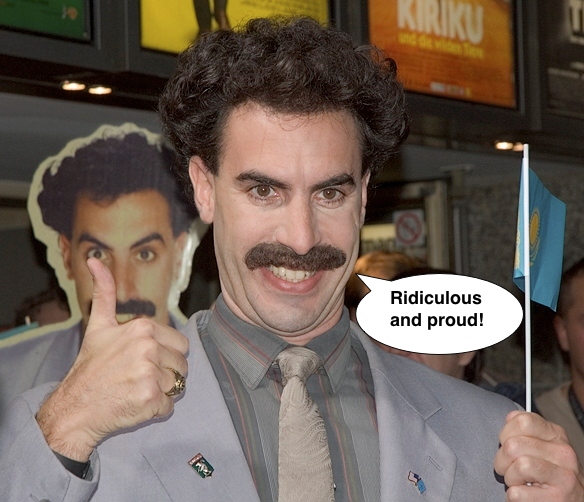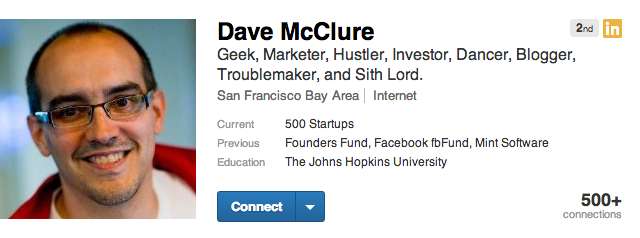Ridiculous people – they’re everywhere. You see them in San Francisco’s Marina District and in your favorite TV shows. You may even have to deal with them on a daily basis at work. Sometimes we laugh at them; sometimes we just plain hate them. But one thing is certain: we never want to be ridiculous.

It shouldn’t surprise you that ridiculous people are also prevalent on social networks. While it’s easy to spot these sad saps on Facebook, Twitter, and similar networks, it’s a bit trickier when it comes to the “professional social network” — LinkedIn.
But beware, professional or not, ridiculous people flock to LinkedIn, too.
In order to help you avoid these folks (and to avoid being one!), I’m going to give you some tips on how to write your LinkedIn profile without sounding ridiculous.
Let’s get started!
LinkedIn Profile Mistake #1 – The Buzzword Buffoon
Well-documented and easily avoidable, the Buzzword Buffoon continues to be the most prolific type of ridiculous user on LinkedIn. Buzzwords are words that were once useful for describing something (like a skill set) but have been so overused that they have become trite. Think of these oldies but not-so-goodies:
- self-starter
- hard-working
- high attention to detail
- natural leader
This pathetic practice has become so common on LinkedIn that the site publishes an annual list of top 10 overused buzzwords.
But what’s the matter with buzzwords if they truly describe my skills?
I’m so glad you asked! Allow me to educate…
Not too long ago, someone looking to hire a really great developer in Silicon Valley used the word rockstar to describe his ideal candidate. At the time, this was a great idea. A rockstar developer conveys that you are the best. You’re amazing at what you do; there aren’t many of you, and anyone that isn’t a rockstar developer need not apply.
This was such a great tactic that other people began using the term in their job postings. They too wanted rockstar developers, and by golly, they were going to get them. Pretty soon, everyone wanted a rockstar developer.
Guess what happened next? All the crappy developers started describing themselves as rockstars. They wanted to be hired! But all this did was dilute the term.
As a result, the term rockstar developer no longer narrows the field of applicants and attracts top talent. Instead, it attracts a bunch of open-mic, rockstar wannabes and causes the real rockstar developers to roll their eyes at out-of-touch employers.
Remember, true rockstars don’t need to tell people they are rockstars. They just are rockstars.
The term rockstar developer has become trite, obsolete, and incapable of fulfilling its original intent. It is a buzzword. So if you’re using buzzwords to write your LinkedIn profile, you look like a buffoon. If anything, you’re communicating that you’re not actually a rockstar, but a roadie at best.
OK, that makes sense, but how am I supposed to describe myself if I can’t use super-awesome, descriptive buzzwords?
Simply put: stop telling and start showing. You don’t need fancy, well-thought-out adjectives to convey how badass you are. All you really need to do is lay down the facts and show your reader you’re legit. Remember, rockstars don’t need an introduction.
Need an example? Check out Dave McClure’s LinkedIn profile.
 Dave is a bonafide badass, but he doesn’t use any lame, descriptive adjectives or buzzwords to communicate it. He tells you the companies he’s been a part of, projects he’s been involved in, and investments he’s made.
Dave is a bonafide badass, but he doesn’t use any lame, descriptive adjectives or buzzwords to communicate it. He tells you the companies he’s been a part of, projects he’s been involved in, and investments he’s made.
When you finish reading Dave’s profile, you think to yourself, “Wow, this dude is legit.” And he is. Strive to write your profile in this manner, and you’ll avoid becoming a Buzzword Buffoon. Congrats!
LinkedIn Profile Mistake #2 – The Grammar Goof
Seriously? LinkedIn paints itself as the “professional” network, and you have grammar errors in your profile summary? Lame.
I get it. Grammar may not be your strong suit, and improving it may not be one of your top priorities. But not looking like a Grammar Goof should definitely be on the top of everyone’s priority list. If you don’t know how to make your LinkedIn profile awesome, Kibin can help. We proofread and edit LinkedIn profiles all the time.
Come on, dude, everyone makes the occasional typo and grammar error. It’s not that big of a deal!
That’s where you’re wrong. Before you go discounting good grammar or the occasional typo, go read this little ditty by Kyle Wiens, CEO of iFixit.
Too lazy to bop on over there for a hot second? Ugh, alright…
In a nutshell, Kyle says that if you don’t have a good grasp on grammar, spelling, and punctuation, he simply won’t hire you. This may seem harsh and unreasonable, but Kyle’s reasoning goes far beyond grammar (as it should). He argues that an individual’s tendency to be flippant with his grammar is a telltale sign he will treat other duties with the same attitude.
Don’t agree? Imagine you’re out to dinner, a first date perhaps, with a nice, charismatic, down-to-earth guy or gal. Now imagine that throughout the entire night your date speaks condescendingly to your waiter and treats him like crap.
Is this someone you’d want to date? What other aspects of a relationship do you think this sort of behavior would bleed into? Kyle’s argument regarding good grammar is highly justified when you look at it, and understand it, from this angle.
But treating waitstaff like crap is the only way to show them that I’m better than them. This Kyle guy is obviously just an outlier.
Ummm… I’m going to pretend you didn’t say that.
Kyle definitely isn’t an outlier. In fact, most employers will immediately dismiss candidates based on typos in their resumes. CareerBuilder published some interesting data on this subject.
CareerBuilder asked employers what would make them automatically dismiss a candidate from consideration, and the number one answer was resumes with typos. A whopping 61% of respondents cited this gaffe as grounds for a candidate’s dismissal. If you’re looking for work, that’s one potentially costly typo!
Your LinkedIn profile is public, and it’s safe to assume it holds as much weight as your resume. Do yourself a favor, and make sure to write a typo-free and grammatically correct LinkedIn profile.
LinkedIn Profile Mistake #3 – The Third-Person Nerd
These guys are the most psychologically interesting LinkedIn users (not to mention they annoy the heck out of me). Third-Person Nerds actually talk about themselves in the third person.
If you don’t understand what I’m talking about, watch this snippet from Seinfeld:
Besides watching this episode, Travis has never actually experienced someone constantly talking about themselves in the third person. I’m a bit baffled about why this behavior has leaked into the online profile summaries of LinkedIn users.
Writing in the third person about yourself is just as bad as speaking in the third person about yourself. It’s awkward, odd, and unclear. Is this you writing about yourself, or did someone else actually write your profile summary for you? Let’s get something straight: this is not some Wikipedia profile that someone else wrote about you. You’re simply not that important.
I’m going back to Dave McClure’s LinkedIn profile for a moment because he’s a badass, and he does a great job of avoiding writing about himself in the third person. Notice how Dave uses the phrasing: “After leaving PayPal in 2004, I was…”. He doesn’t say, “After leaving PayPal in 2004, Dave was…”
Dave keeps his summary personal and in the first person because writing in the third person leaves a bad taste in the reader’s mouth. Why? It’s conceited. In fact, there’s a word for speaking in the third person. It’s called illeism.
Illeism has a few different definitions depending on context, but when using this way of speaking in your LinkedIn profile, it falls under the following:
“Idiosyncratic and conceited people are known to either use or are lampooned as using illeism to puff themselves up or illustrate their egoism.” (via Wikipedia)
Hmmm, yeah… that’s not really the message you want to convey to anyone, let alone on your professional, public profile.
So if you’ve written your LinkedIn profile in the third person, hopefully I’ve convinced you to scamper on over there and change it to the first person immediately.
While these are just three LinkedIn profile blunders, I’m sure there are more that we’re missing. What have you seen on LinkedIn that makes you roll your eyes? What would you add to our list? What other tips would you include for writing a LinkedIn profile? Let us know in the comments!